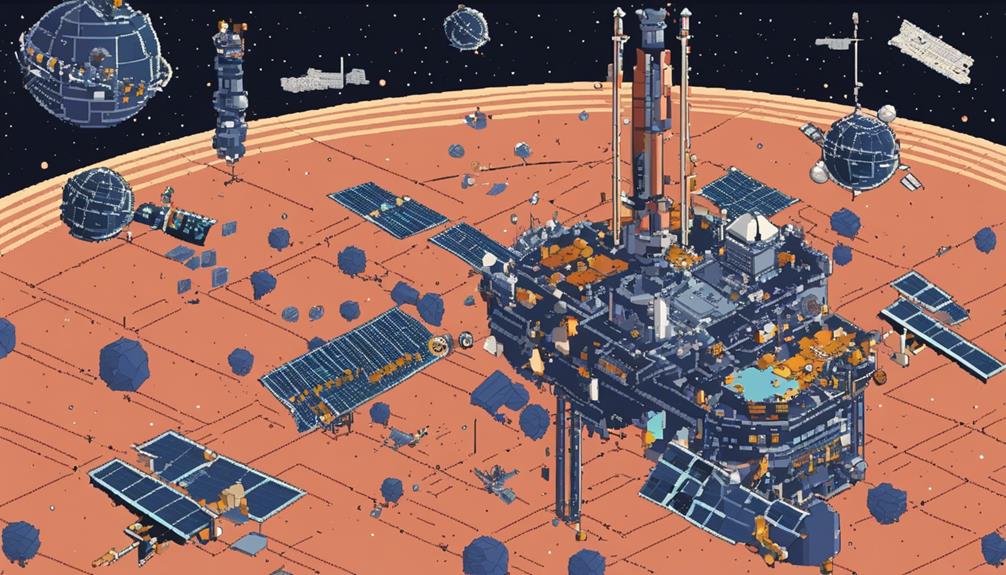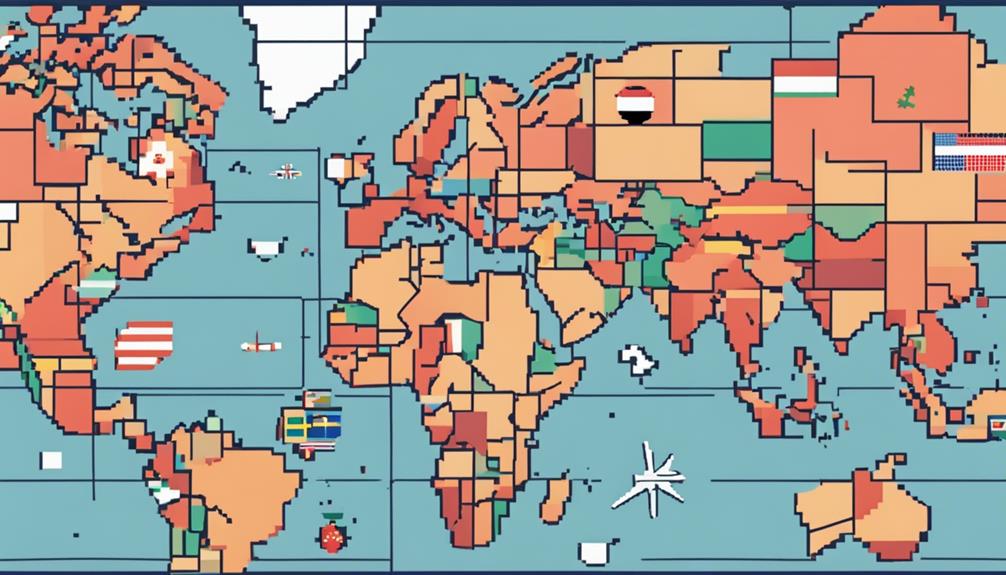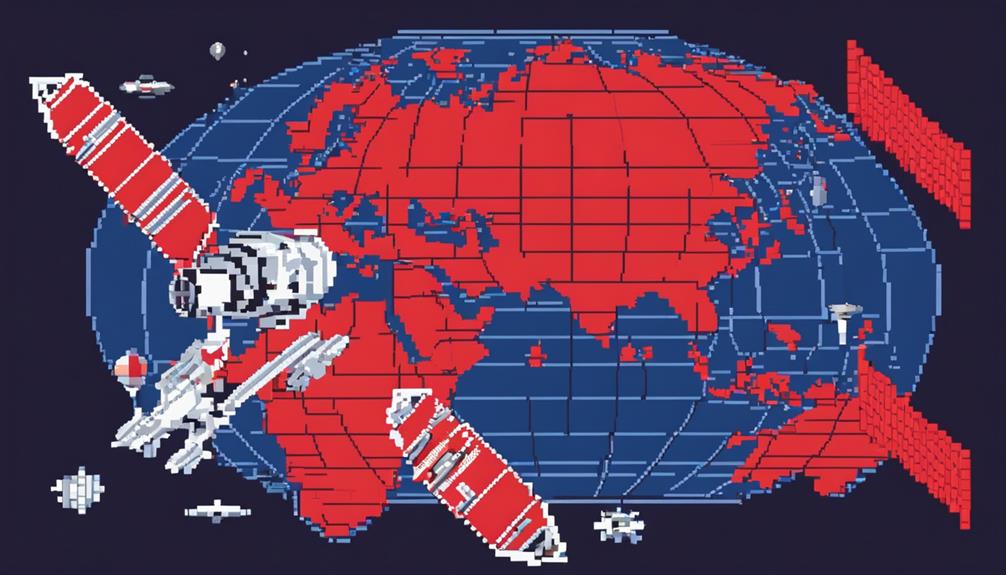The realm of satellite network operations is confronted with a myriad of regulatory challenges that demand meticulous attention. From the intricate web of licensing requirements to the intricacies of spectrum allocation and security compliance, the landscape is rife with complexities. As small satellite operators grapple with ambiguous frameworks and mounting space debris concerns, the need for a comprehensive regulatory strategy becomes all the more imperative. In this intricate dance between technological advancement and regulatory oversight, the future trajectory of satellite network operations hangs in a delicate balance, calling for a deeper exploration into the evolving regulatory landscape.
Key Takeaways
- Compliance with international treaties and national regulations is paramount for satellite network operations.
- Data privacy, security, and encryption protocols are crucial regulatory considerations.
- Licensing requirements for space and ground segments ensure operational legality.
- Balancing innovation with legal compliance is essential for sustainable satellite operations.
Overview of Satellite Network Regulations

Navigating the intricate web of international treaties and regulations, satellite network operators must adhere to a complex framework that governs their operations. In the realm of International Telecommunications, satellite networks are subject to various regulatory measures to ensure seamless global connectivity. At the core of these regulations lies the 1967 Outer Space Treaty, which establishes principles for the use of outer space, including the Moon and other celestial bodies. This treaty forms the foundation for satellite network operations, emphasizing peaceful cooperation and the prohibition of placing nuclear weapons in space.
Additionally, the International Telecommunications Union's Radio Regulations are instrumental in overseeing the allocation of radio frequency spectrum and orbital slots for satellite communication. These regulations help prevent harmful interference among satellite networks and ensure efficient spectrum utilization. Satellite operators must comply with these regulations to operate within designated frequency bands and orbital locations, promoting international coordination and cooperation in telecommunications activities.
The multifaceted nature of satellite networks presents unique legal challenges, especially concerning data privacy, security, copyright infringement, and taxation. Addressing these issues requires a comprehensive regulatory framework that balances technological advancements with legal considerations to foster innovation while safeguarding users' rights. By adhering to international treaties and regulations, satellite network operators can navigate the complex landscape of International Telecommunications while ensuring the reliability and security of their services.
Licensing Requirements for Satellite Networks
Licensing requirements for satellite networks are multifaceted, encompassing the acquisition of frequency licenses for telemetry, tracking, and control (TT&C) operations within specific countries. Distinctions exist between the obligations of operators engaged in bandwidth wholesaling versus those facilitating direct connectivity to end users. Additionally, the importance of satellite landing rights in various jurisdictions for foreign satellites to transmit signals cannot be overstated.
Regulatory Compliance Essentials
Compliance with regulatory licensing requirements is an imperative facet of satellite network operations, encompassing authorization for space segment activities, obligations related to ground segment operations, and the essential acquisition of frequency licenses from national telecommunications authorities. Regulatory requirements necessitate obtaining satellite landing rights, adhering to type approval requirements, and ensuring legal operation through frequency licensing. The table below summarizes key licensing requirements for satellite networks:
| Licensing Requirement | Description | Examples |
|---|---|---|
| Space Segment Authorization | Authorization for satellite deployment and operation in compliance with international treaties | Outer Space Treaty compliance |
| Ground Segment Obligations | Compliance requirements based on the service provided, like bandwidth wholesaling | Direct end-user connectivity obligations |
| Frequency Licensing | Obtaining licenses from national telecom authorities for legal satellite network operations | Spectrum licenses for radio frequency use |
Licensing Process Overview
Securing the necessary authorizations for satellite network operations involves a meticulous process of ensuring compliance with regulatory frameworks governing space and ground segments. Licensing process for satellite networks entails obtaining authorization for both the space and ground segments to operate within legal boundaries. Satellite operators must obtain frequency licenses from national telecommunications authorities to guarantee adherence to regulations. The licensing requirements vary depending on whether operators are offering bandwidth wholesaling services or direct connectivity to end users. Furthermore, ground segment licensing may necessitate satellite landing rights in specific jurisdictions for foreign satellites to transmit signals effectively. For operators providing connectivity directly to end users, strict compliance with national regulatory frameworks is imperative to ensure seamless operations within the industry.
Spectrum Allocation Challenges for Satellites

Amidst the challenges of spectrum allocation for satellites, the limited availability of designated radio frequency bands poses a significant hurdle for satellite operators. Satellite communication heavily relies on specific frequency bands allocated by regulatory bodies, such as the International Telecommunication Union (ITU) Radio. However, the demand for spectrum resources from terrestrial wireless services has intensified, leading to spectrum scarcity issues for satellite operators. This competition for spectrum allocation impacts the performance and capacity of satellite networks, directly influencing the quality of service delivered to end-users.
Regulatory bodies like the ITU Radio play a crucial role in mitigating these spectrum allocation challenges by overseeing the allocation process to ensure fair distribution and prevent interference between different satellite systems. Coordination among satellite operators, regulatory authorities, and other stakeholders is essential to optimize the usage of available spectrum resources efficiently. Failure to address spectrum allocation challenges can result in congestion, reduced network reliability, and compromised service quality for satellite communication systems. Therefore, proactive measures and effective collaboration are imperative to navigate the complexities of spectrum allocation and enhance the overall performance of satellite networks.
Privacy and Data Protection Regulations
Ensuring the privacy and security of user data is a critical priority for satellite network operators, necessitating strict adherence to data protection regulations such as GDPR. Satellite operations involve the transmission and storage of vast amounts of user data, ranging from communication records to location information. To address the challenges associated with data privacy, satellite operators must implement robust data encryption protocols to safeguard sensitive information from unauthorized access. Compliance with international data privacy standards, like the General Data Protection Regulation (GDPR), is essential, especially for satellite networks that operate across various jurisdictions.
Privacy and Data Protection Regulations Table:
| Challenges | Solutions |
|---|---|
| Compliance with GDPR | Implement data encryption protocols |
| International data privacy standards | Ensure robust data protection measures |
| Prevent unauthorized access | Regular security audits |
| Severe penalties for violations | Strict adherence to regulations |
Failure to comply with data protection regulations can lead to severe penalties, undermining the trust of users and regulatory authorities. Therefore, satellite network operators must prioritize data privacy and protection to maintain operational integrity and regulatory compliance. In the ever-evolving landscape of data privacy, staying abreast of regulatory updates and continuously enhancing data protection measures are imperative for satellite operators to uphold the trust and security of their users' information.
Security Compliance in Satellite Operations

Implementing robust security compliance measures is crucial for satellite operators to mitigate cyber threats and protect sensitive data in their operations. In the realm of satellite operations, security compliance is a multifaceted approach that involves the implementation of various measures to ensure the integrity and confidentiality of data transmitted and processed. Here are three key security measures that satellite operators employ to enhance their security posture:
- Encryption Protocols: Satellite operators utilize advanced encryption protocols to secure their communications and data transmissions. Encryption helps protect data from unauthorized access and ensures that sensitive information remains confidential during transit.
- Secure Data Processing Techniques: Implementing secure data processing techniques is vital to safeguarding information within satellite networks. Techniques such as data anonymization, access controls, and secure data storage mechanisms contribute to maintaining the integrity of data throughout its lifecycle.
- Threat Intelligence Platforms: Satellite operators leverage threat intelligence platforms to proactively identify and mitigate potential security threats. These platforms enable operators to stay informed about emerging cyber threats, assess their impact on satellite operations, and take necessary precautions to prevent security breaches.
Environmental Regulations Impacting Satellite Networks
Environmental regulations play a crucial role in shaping eco-friendly practices within satellite networks, emphasizing compliance with emission standards to reduce the industry's environmental impact. Satellite operators must adhere to stringent regulations governing emissions and environmental practices to ensure sustainable satellite operations. By integrating eco-friendly measures, operators can contribute to minimizing orbital pollution and promoting responsible space management.
Eco-Friendly Satellite Practices
Amidst the evolving landscape of satellite network operations, the burgeoning emphasis on eco-friendly satellite practices has become a pivotal focal point due to regulatory frameworks addressing space debris mitigation and environmental impact assessments. Satellite operators are increasingly pressured to adopt sustainable approaches to minimize their environmental footprint and ensure responsible space operations. Key considerations in implementing eco-friendly satellite practices include:
- Use of Biodegradable Materials: Incorporating materials that degrade over time can reduce the long-term impact of satellites on the space environment.
- End-of-Life Disposal Strategies: Developing efficient strategies for satellite disposal to prevent the proliferation of space debris.
- Sustainable Design Practices: Implementing design practices that reduce space debris creation and ensure minimal environmental impact throughout the satellite's lifecycle.
Compliance With Emission Standards
The imperative for satellite operators to adhere to stringent emission standards as mandated by environmental regulations underscores the critical role of minimizing electromagnetic radiation emissions from satellite networks to mitigate interference risks and protect the environment. Compliance with emission standards is essential for satellite networks to operate within permissible limits, as set forth by regulatory guidelines. These standards aim to prevent interference with other systems and safeguard living organisms from excessive electromagnetic radiation exposure. Environmental regulations impacting satellite networks emphasize the need for sustainable practices to reduce the ecological footprint of satellite operations. Failure to comply with emission standards can lead to regulatory fines and penalties for satellite operators, highlighting the significance of adherence to environmental regulations in the satellite industry.
International Coordination in Satellite Operations

Effective international coordination in satellite operations necessitates meticulous adherence to a complex web of national and international regulations governing licensing requirements and frequency authorizations across multiple jurisdictions. Satellite operators must navigate this intricate landscape to ensure seamless connectivity and compliance with various regulatory frameworks. The following key points highlight the importance of international coordination in satellite operations:
- Regulatory Compliance: Satellite operators face the challenge of complying with diverse licensing requirements and frequency authorizations across different countries. Understanding and adhering to these regulations are essential for maintaining operational efficiency and legal compliance on a global scale.
- ITU Cooperation: Collaboration with the International Telecommunication Union (ITU) is vital for managing satellite network information and spectrum allocation internationally. Working closely with the ITU enables satellite operators to coordinate frequencies, resolve interference issues, and optimize spectrum use efficiently.
- Harmonization of Operations: Harmonizing ground segment operations and licensing processes worldwide is crucial for ensuring the smooth functioning of satellite networks. By aligning standards and procedures across jurisdictions, satellite operators can mitigate operational challenges and enhance overall network performance.
Liability Issues in Satellite Network Operations
Navigating the intricate landscape of liability issues is paramount for satellite operators engaged in network operations. The legal framework surrounding liability in satellite network operations is primarily governed by international agreements such as the Space Liability Convention and the Outer Space Treaty. These regulations aim to hold states launching satellites accountable for any damages caused by their objects in outer space, emphasizing the importance of understanding and adhering to liability provisions to ensure responsible satellite activities.
To grasp the complexity of liability issues in satellite network operations, it is beneficial to analyze the key aspects that satellite operators need to consider:
| Aspect | Description | Importance |
|---|---|---|
| State Liability | States launching satellites bear liability for damages caused by their space objects. | Ensures accountability for space activities. |
| International Space Laws | Compliance with international space laws, including the Outer Space Treaty, is vital. | Ensures adherence to established legal frameworks. |
| Risk Mitigation | Implementing measures to mitigate risks associated with satellite operations. | Minimizes the likelihood of accidents and damages. |
| Liability Allocation in Commercial Ventures | Determining liability in commercial satellite operations. | Clarifies responsibilities in private-public partnerships. |
Satellite Debris Mitigation Regulations

Satellite debris mitigation regulations encompass crucial aspects such as debris monitoring requirements and the necessity of compliance with established guidelines. These regulations set forth specific measures that satellite operators must adhere to in order to mitigate the risks associated with space debris. By focusing on debris monitoring and guideline adherence, satellite operators can contribute to maintaining the sustainability of satellite networks and minimizing potential collisions in space.
Debris Monitoring Requirements
Monitoring debris in Earth's orbit is a critical component of ensuring satellite operators comply with debris mitigation regulations. Debris monitoring requirements play a crucial role in maintaining the sustainability of space activities. Here are three key aspects related to debris monitoring:
- Continuous Tracking: Satellite operators must track the movement of space debris to predict potential collisions accurately.
- Collision Avoidance Measures: Implementing collision avoidance maneuvers based on real-time debris monitoring data is essential to safeguard operational satellites.
- Reporting Obligations: Operators must adhere to reporting obligations regarding any observed debris that could pose a threat to other satellites or spacecraft in orbit.
Compliance With Guidelines
In ensuring the sustainability of space activities, one pivotal aspect that satellite operators must prioritize is the stringent compliance with satellite debris mitigation regulations. These guidelines, established under the Registration Convention, encompass crucial measures aimed at minimizing space debris generation, preventing collisions, and ensuring proper post-mission disposal of satellites. Adherence to satellite debris mitigation regulations is imperative to uphold the integrity of space operations and safeguard operational satellites and other spacecraft from heightened risks. Regulatory bodies such as the ITU and national space agencies play a vital role in enforcing these guidelines to preserve the space environment. Failure to comply with satellite debris mitigation regulations could have detrimental effects on the safety and longevity of space activities, emphasizing the critical importance of regulatory compliance in satellite network operations.
Emerging Technologies and Regulatory Considerations
Amidst the rapid evolution of satellite network technologies, the emergence of IoT, AI, and machine learning ushers in a new era of regulatory challenges requiring updated frameworks to address data privacy and security concerns. These advancements bring about a host of complexities that demand careful attention from regulatory bodies:
- Data Privacy and Security: With the integration of IoT, AI, and machine learning in satellite networks, ensuring comprehensive data privacy measures and robust security protocols becomes paramount. Regulators need to establish guidelines to safeguard sensitive information transmitted and processed within these networks.
- Encryption Standards: Quantum encryption and blockchain applications in satellite communications introduce novel regulatory challenges concerning data protection and encryption standards. Regulators must adapt existing frameworks to accommodate these cutting-edge technologies while upholding stringent security requirements.
- Efficient Network Management: Advanced satellite propulsion systems and autonomous satellite operations necessitate tailored regulations to guarantee safe and efficient satellite network management. Regulators face the task of defining operational boundaries to optimize network performance while ensuring compliance with safety standards.
These emerging technologies not only enhance the capabilities of satellite networks but also demand a proactive regulatory approach to address the intricate legal and security implications they entail. Regulators must act as a comprehensive resource to navigate the evolving landscape of satellite network operations effectively.
Compliance With National Space Laws

Ensuring compliance with national space laws is imperative for satellite operators to secure the necessary legal authorization for their operations. National space laws serve as the regulatory framework that governs satellite activities within a specific jurisdiction. Compliance with these laws is crucial as it ensures that satellite operators adhere to the established rules and requirements, thereby promoting responsible and lawful conduct in space operations.
However, navigating the various national space laws can present significant challenges for satellite operators. These laws differ across jurisdictions in terms of licensing requirements, operational restrictions, and compliance obligations. Satellite operators must carefully study and understand the specific provisions outlined in each country's space laws to ensure full compliance and avoid potential legal consequences.
Non-compliance with national space laws can lead to severe penalties, fines, or even the suspension of satellite operations. Therefore, satellite operators must prioritize compliance efforts to mitigate risks and maintain operational continuity. Obtaining the necessary authorizations, licenses, and permissions as mandated by national space laws is essential for conducting satellite network operations legally and ethically.
Future Trends in Satellite Network Regulations
As satellite network operations continue to evolve, future trends in regulations are increasingly emphasizing the implementation of space debris mitigation measures to ensure the sustainability of satellite activities. This focus on space debris mitigation is crucial due to the growing number of satellites being launched into orbit and the resulting increase in space debris, which poses risks to operational satellites and spacecraft. To address this challenge, regulatory frameworks are adapting to integrate specific requirements aimed at mitigating space debris. Key trends in satellite network regulations regarding space debris mitigation include:
- Adoption of Debris Mitigation Guidelines: Regulators are expected to mandate adherence to international debris mitigation guidelines, such as those provided by organizations like the Inter-Agency Space Debris Coordination Committee (IADC), to limit the creation of new space debris and minimize collision risks.
- Incorporation of End-of-Life Disposal Requirements: Future regulations may enforce strict end-of-life disposal protocols for satellites, ensuring that operators deorbit or move their satellites to graveyard orbits at the end of their operational lives to reduce the accumulation of defunct satellites in key orbital regions.
- Promotion of Active Debris Removal Technologies: Regulatory initiatives may incentivize the development and deployment of technologies for active debris removal, encouraging innovation in methods to actively clean up existing space debris and mitigate collision hazards in orbit.
Frequently Asked Questions
What Are Some Challenges in Communicating With a Satellite?
Challenges in communicating with a satellite include signal interference, which can disrupt transmissions and degrade communication quality. Factors like atmospheric conditions, solar activity, and frequency coordination issues can contribute to this interference. Additionally, obstacles that block line-of-sight communication, such as buildings or terrain features, may impede signal reception. Weather conditions like heavy precipitation can further attenuate satellite signals, affecting the reliability of the communication link.
What Are the Major Problems of Satellites?
Space debris poses a significant challenge for satellites, as the increasing number of objects in orbit presents risks to operational spacecraft. The proliferation of space debris requires satellite operators to implement robust mitigation strategies to safeguard their assets. Mitigation measures may include collision avoidance maneuvers and end-of-life disposal procedures to minimize the potential impact of space debris on satellite operations.
How Are Satellites Regulated?
Satellites are regulated through a combination of international treaties and national legislation to ensure regulatory compliance. These regulations encompass various aspects such as licensing, frequency coordination, and spectrum management. Operators must adhere to specific filing and notification processes established by the International Telecommunication Union (ITU) to operate within the allocated spectrum. Regulatory frameworks differ for different types of satellites, with Non-Geostationary Orbit (NGSO) satellites subject to different requirements compared to Geostationary Orbit (GSO) satellites.
What Are the Vulnerabilities of Satellite Telecommunications?
Satellite security faces vulnerabilities stemming from its expansive coverage area and complex system architecture. Threats such as physical attacks, interference, and cyber intrusions exploit these weaknesses, jeopardizing the integrity of satellite telecommunications. The intricate design of satellite networks, with numerous interconnected components, increases the susceptibility to breaches. Safeguarding satellite communications against such vulnerabilities requires robust security measures and proactive monitoring to mitigate risks effectively and ensure uninterrupted operations.

